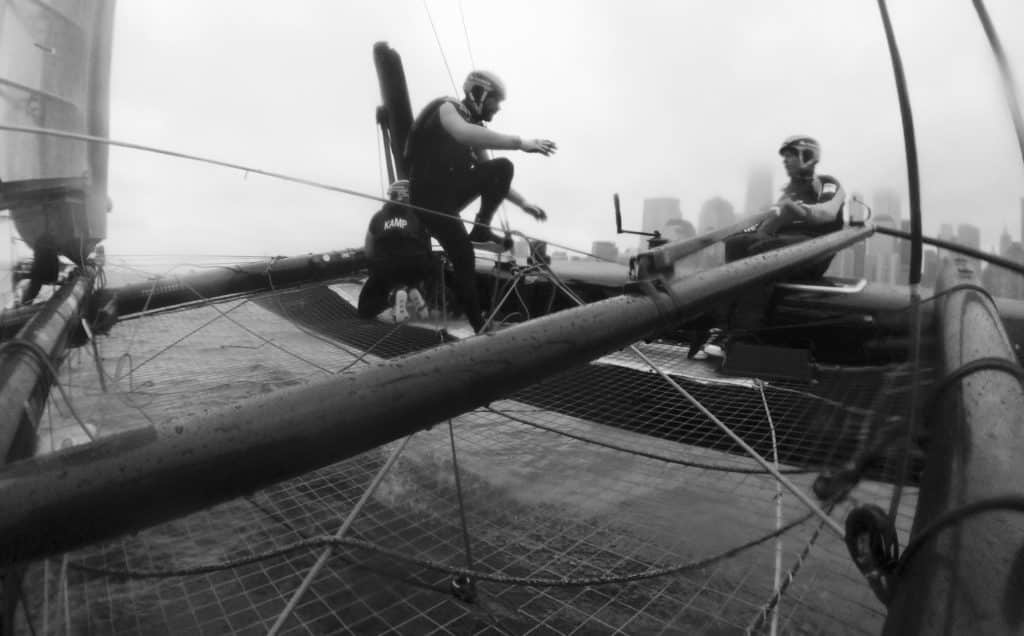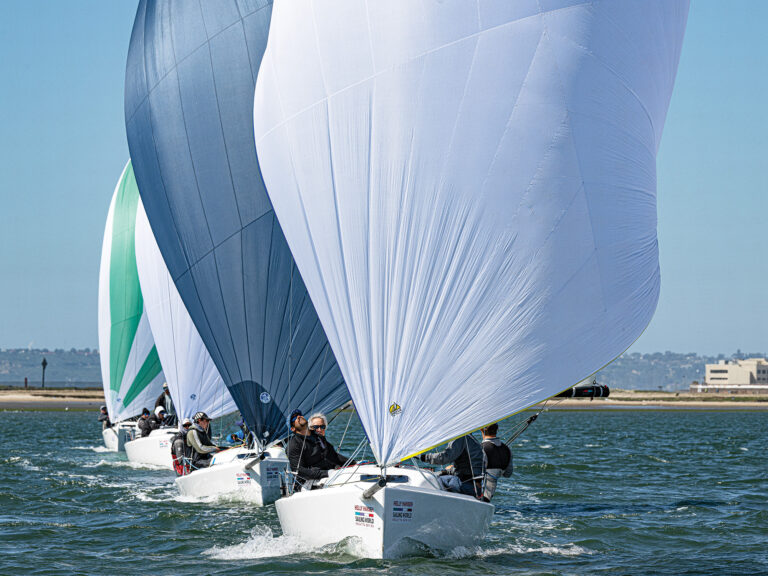
“Looks good boys,” says Artemis Racing’s Iain Percy as we motor toward the team’s blue-hulled AC45 on its mooring. “Ben’s boat looks like a dog covered in stickers.”
Ben’s boat, of course, is the grey one belonging to their neighbor, Ben Ainslie’s Land Rover BAR, which swings on its mooring nearby.
It’s all in good fun, the usual ribbing of the Cup’s only knighted skipper, but there’s a reverse of tone as we pull up alongside Artemis’ own AC45. Laid back and jovial on the short RIB ride from the base, as soon as they step on board cat and switch into race mode, the transformation is immediate. Once the mooring line slips away and the wing sheet gets wound on the winch, there’s no space or time for jokes. It’s all awareness, all the time. For the practice races of the Louis Vuitton America’s Cup World Series in New York, I’ve lucked into the guest racer position onboard Artemis. I’m issued foul weather gear, a PFD and a helmet and instructed by Artemis coach Tom Burnham to just hang tight behind the aft beam, on a foot-wide section of trampoline netting, inside the blue rope that Burnham calls the “oh-shit” line.
Sit back and enjoy the ride are my orders. I remind myself to never—ever—touch the tiller bar. The crew, which includes Percy, skipper Nathan Outteridge, Luke Parkinson, Christian Kamp and smiling Kalle Torlen know I’m there (I think), but they could care less. With the wind whistling across the Hudson River at 10 knots and ferry traffic passing through the racecourse horns blazing, all eyes are outside the boat. After barely getting across the bow of one ferry, we hum across the river toward downtown Manhattan, the World Trade Center, and the World Series Regatta Village tents.
As sailors do in any other race at any other regatta, they sail the racecourse and get a feel for the conditions: one reach, one speed burn on the foils, a few minutes upwind to check the jib leads and shape, a few tacks, a few jibes, and then hover along the Manhattan shoreline to await further instructions from regatta director Iain Murray.
“Definitely better pressure out on the left,” says Percy. The left is the Jersey. The right is Manhattan. The breeze is blowing from the east, squeezed by skyscrapers before spewing out as ribbons of dark streaks on the gray water. Conditions are exactly as hyped: a swift running current and a patchwork of wind. A cold drizzle adds to the misery.
Percy and Outteridge discuss whether a Code Zero deployed at the start is the right move. For now, it’s light enough to need it, but if a gust should drop out of nowhere, they’d be caught too much sail on the first-leg reach. There’s no consensus.
As the floating digital clock bobbing in the chop ticks down into the final seconds, the boat inches forward near the top of the starting line. Land Rover BAR is 50 feet to leeward, carrying a head of steam already. Kamp winds the winch and says, “Max trim.”
Outteridge jabs the tiller toward him, peers beneath his wing and says, “Ben’s close to being over.” Wind and water rush, foils moan and winches groan and Outteridge peaks again below the wing and confirms aloud that Ainslie is over. He points his bows straight toward the first turning mark, but watches Land Rover attentively as the two cats converging within 20 feet of each other.
“Hey, hey, hey!” hollers Outteridge. “Go down! Hey Ben you’ve got a penalty!” Ainsle pays no attention.
One minute later of starboard-tack reaching toward Jersey, Percy moves off the weather hull to set up for the first jibe.
“Two…one…go board…OK, here we go,” hails Outteridge in a calm cadence. Bodies in dark blue and yellow stripes furiously pull on ropes, scramble across the boat one by one and take positions on the port hull as the boat accelerates.
“OK, wind it up,” hollers Outteridge, taking the wing sheet over from Percy and grunting two half-rotations on the winch handle without ever looking down at his task. His movements are highly mechanical and his eyes dart all around the boat, scanning for potential issues, like the leeward runner winch, which has a second wrap (He later explains that if there’s a second one, the runner can’t get eased fast enough, which pins the trailing element of the wing and pulls the boat into a slow-motion capsize. This one pre-flight check is burned into his brain).
As the first downwind and down-current leg passes disappears at 20 knots they have little time decide on which of the two gate marks to round. Ainslie is ahead and going for the left. Percy reminds Outteridge that Ainslie is still carrying a start penalty. He rapidly swivels his gaze back and forth over his shoulder looking for the next puff and responds, “Yeah, well, he’s not playing fair at the moment.”
The gate-decision is upon them within seconds and Land Rover BAR has come to a grinding halt as it turns the Manhattan-side mark. They’re windless and the current has them in its grips, pulling them seaward.
Outteridge reacts with a hasty call to switch to the Jersey-side mark, followed by a jibe. As he steps across the trampoline, his right hand sweeps across the tiller bar, grabbing hold of it twice with his fingertips. His left hand reaches out for the bottom corner of the wing, squeezes it and falls away. This movement, too, is naturally mechanical. His muscle memory is sharp from years of 49er and AC sailing. The starboard foil-tipped daggerboard submerges, the Code Zero comes “off the lock” and snakes onto the trampoline as the starboard bow passes the mark and onto the upwind leg. It’s basic boathandling the guys, executed many times over.
Well out front of rest of the fleet, away from the city and in the best breeze on the course, they extend their lead even further before reaching the Jersey-side course boundary. Parkinson and Torlen drape their bodies off the bow section while Kamp, the team’s newcomer, grinds the jib home. As they near the boundary, Outteridge momentarily shifts his attention to the electronic display at his right hip, checking his distance. In this nanosecond of inattentiveness the boat has turned ever so slightly off the wind and immediately someone senses they’re off course, calling out, “Bow up, bow up!”
Outteridge nudges the black tiller extension away from his body a few inches and boat swings 10 degrees closer to the wind.
A tack toward the city front soon follows.
“Come out high,” advises Percy. “The angle’s pretty reachy.”
They settle in on the new tack and begin strategizing how to best get through the upwind gate marks. The current is dramatic and it appears as if the high-rise towers are on a scrolling billboard the likes you’d see in nearby Times Square. There’s only a slight concern over fetching the left-most upwind mark, a bright red Oracle-branded float with a big antenna.
“High mode is key,” says Percy.”
When there’s doubt they’ll make it, the wind veers right, allowing them to easily clear past the mark. Outteridge peers over his right shoulder, and in the next puff they tack. The boat slows, as it does every time, Torlen trims the jib and now the right mark is a concern as the boat slides sideways with pace until the carbon foil bites into the Hudson and flow attaches, translating into forward thrust.
The mark passes by the starboard hull three feet away. The turbulence of the current is boiling against the mark’s rigid base. Outteridge gives it a passing glance.
The final spring of the four-leg race is a straight shot toward the umbrellas and spectators along the seawall of North Cove and Brookfield Place where the regatta’s race village is staged. Kamp winches out the Code Zero, scans the lines around him and takes a seat on the starboard hull, just as the boat levels out horizontal, elevating onto its foils.
Flying toward the finish gates, Outteridge says, “Well sailed boys, that was a good one.” Parkinson, way up at the front the boat, turns his head toward Outteridge and corrects him.
“We haven’t finished yet,” he says and then drops out of sight, only his legs and lime-green sneaker soles visible over the top of the hull.
Twenty seconds later, Artemis’ bows cross the finish, and Outteridge offers another, “Well done boys,” before turning the boat downwind. The boat plummets off its foils with a flush of river water shooting up through the trampoline and he leans in, gently places the tiller extension in its holding bracket, again without even looking. All his movements are subconscious.









